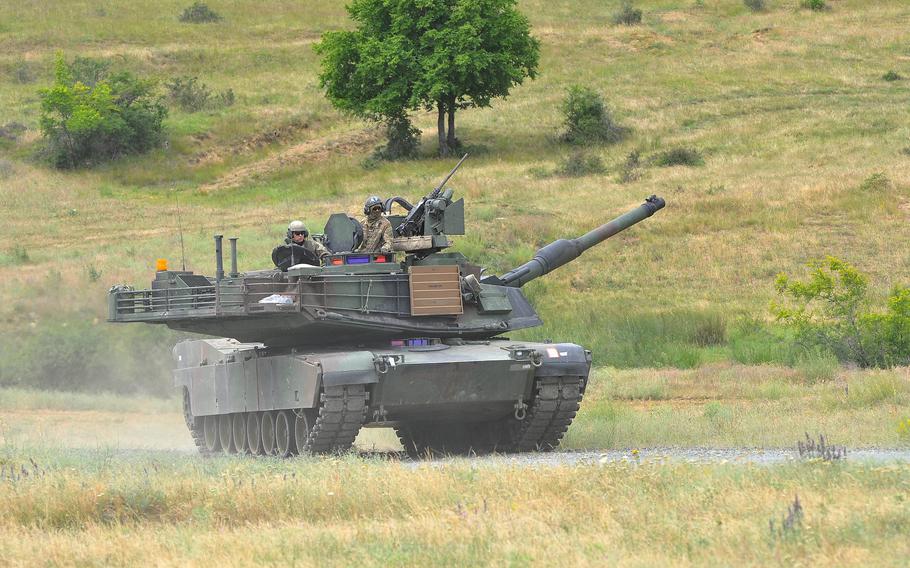
A U.S. Army M1A2 Abrams tank, manned by soldiers of the 3rd Combined Arms Battalion, 69th Armor Regiment, rumbles across Novo Selo Training Area, Bulgaria, following a live-fire exercise that closed the Kabile 2015 tactical exercise at the training area, Thursday June 25, 2015. (Michael Abrams/Stars and Stripes)
NOVO SELO TRAINING AREA, Bulgaria — U.S. battle tanks made a rare appearance Thursday as the Bulgarian military pulled out all the stops for a live-fire training exercise aimed at showing its ability to partner with American ground troops in a simulated combat environment.
Villagers whose rooftops could be seen in a hamlet neighboring the exercise viewing area may have puzzled at all the commotion that began midmorning. The Kabile 2015 tactical exercise kicked off when a Bulgarian military helicopter swooped in low and commandos rappelled from the bird to the ground.
The next 90 minutes saw a lot of smoke, bullet fire and loud booms, creating the impression at times of a Fourth of July fireworks display. Two Bulgarian jets flew in low, dropping training rounds, as did an attack helicopter. Three Strykers joined the mix, its U.S. soldiers dismounting and running with pointed guns into some bushes.
But the most anticipated players made a late entrance — two M1A2 Abrams tanks airlifted into Bulgaria from Germany and their Bulgarian T-72 counterparts.
U.S. Army Europe called the effort to get the tanks to Bulgaria in quick order “Speed and Power.” This part of the mission was intended to demonstrate its ability to move materiel swiftly within Europe.
U.S. military officials had touted Kabile 2015 as the first time U.S. tanks had been airlifted into Bulgaria — a NATO member since only 2004 — and its guns fired in the former Soviet bloc country.
But in 2005, two M1 Abrams tanks and two Bradley fighting vehicles were airlifted by C-17 cargo planes from Ramstein Air Base, Germany, into Bulgaria’s Bezmer Air Base for Immediate Response 05, a three-week training exercise at Novo Selo that included live-fire tank maneuvers.
Thursday’s exercise comes at a pivotal time for NATO as it seeks to bolster its partnerships and resources to counter Russia’s aggressive stance toward Ukraine. Earlier this week, U.S. Defense Secretary Ash Carter announced the “temporary” placement of 250 armored vehicles in three Baltic countries, as well as Bulgaria, Romania and Poland by next summer. Though the tanks that fired on Thursday will return to Germany, U.S. military officials in Bulgaria this week said future tanks positioned in the country would likely be stored near Novo Selo, the country’s largest training area.
Descending on the training area Thursday was a “who’s who” of Bulgarian politicians and defense leaders. Rosen Plevneliev, Bulgaria’s president and supreme commander of the country’s armed forces, was on hand, along with various members of parliament and defense ministers. After watching from a control tower and a stage set up above the training site, they mingled, snacking on finger food and drinking champagne.
But the most fun was likely had by the soldiers in the exercise.
“I’ve done combined arms live fire with helicopters before but not with jets and tanks and helicopters, so this was actually a new experience for me, and it was really fun,” said Sgt. 1st Class Eric Doolittle, a Stryker platoon sergeant with 2nd Squadron, 2nd Cavalry Regiment, out of Vilseck, Germany.
1st Lt. Frank Wood, a tank commander from 3rd Infantry Division’s 3rd Combined Arms Battalion, 69th Armor Regiment, out of Fort Stewart, Ga., said being in one of the U.S. tanks in the exercise was “a tanker’s dream.”
“With our coax, we were able to fire off like 800 rounds in a minute. That’s a lot of rounds going down range. I’ve never seen anything like that because you never need to expend that much ammo.”
The Americans’ Bulgarian counterparts said they, too, welcomed the training opportunity.
Working together allows “you to see what you have studied,” said Lt. Col. Minev Mincho, the chief of training and exercises for the 2nd Mechanized Brigade.
“As we say, the map is flat. Here you can see what exactly (to do) and how to do it,” he said.
“It’s to show that we are allies and you have the same values and you believe in what you do,” said Brig. Gen. Dimitar Iliev, commander of 2nd Mechanized Brigade. “I think that’s the main message we have to send.”
One of the goals, Mincho added, is to show “that your infantry can work easily with our infantry … not to look like (a) sitcom.”